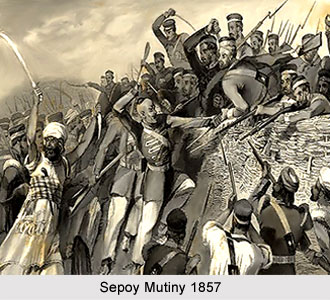 Sepoy Mutiny 1857, also known as Indian Rebellion of 1857, was a rebellion of the native foot soldiers of British Colonised India against the British Empire. It is considered as the first movement against the Britsh rulers which sparked the Indian freedom struggle.
Sepoy Mutiny 1857, also known as Indian Rebellion of 1857, was a rebellion of the native foot soldiers of British Colonised India against the British Empire. It is considered as the first movement against the Britsh rulers which sparked the Indian freedom struggle.
Origin of Sepoy Mutiny
Sepoy mutiny or the Revolt of 1857 was one of the many revolutions to achieve independence. India came under complete control of British in the year 1857 and the constant urge and spirit of freedom started to in built itself in the natives of India. Sepoy mutiny that started long before March of 1857 in Kolkata is known as the first war for independence against British.
Sepoy mutiny though was a widespread movement, but was ultimately unsuccessful and ended its course in 1858. It started from Meerut and eventually started spreading in Delhi, Agra, Kanpur and Lucknow.
Areas of Sepoy Mutiny
The Sepoy Mutiny of 1857 started as a rebellion of soldiers or Sepoys of British East India Company`s army on the 10th of May 1857, in the town of Meerut, and soon ignited into other mutinies and civilian uprisings, mostly in the upper Gangetic Plain and central India, with the major aggressions restrained to present-day Uttar Pradesh, Bihar, northern Madhya Pradesh, and the Delhi region. The insurgents of Sepoy Mutiny speedily captured large portions of the North-Western Provinces and Oudh, including Delhi, where they set up the Mughal ruler, Bahadur Shah Zafar, as Emperor of Hindustan.
Other regions of Company-controlled India-Bengal province, the Bombay Presidency, and the Madras Presidency-remained calm for the larger part. In Punjab, just lately annexed by the British East India Company, the Sikh princes backed the Company by furnishing both soldiers and support. The large princely states, Hyderabad, Mysore, Travancore, and Jammu and Kashmir, as well as the smaller ones of Rajputana, did not participate in the rebellion, and served, in Governor General Lord Canning`s words, as "breakwaters in a storm" for the Company.
Uprising of British Indian Army in Sepoy Mutiny
Mangal Pandey of the 34th Infantry at Barrackpur rebelled by firing at an officer on command against the use of the new cartridges. He was arrested and on 8 April he was hanged to death. This followed with repeated outbreak of revolt at Kolkata and Europeans were in a state of prolonged panic. In April 1857, Indian soldiers at cavalry unit in Meerut refused to use the new cartridges, which ultimately led to their arrest and were thrown into prison.
Although this mutiny started among the native soldiers, the others who weren`t affected by British rule also joined hands. An appeal was forwarded to 82-year-old Mughal Emperor Bahadur Shah Zafar for leading the revolt and proclaimed him the Emperor of India.
Delhi
Delhi was seized by the Sepoys on 12th May 1857. The palace and the city were occupied. The old Mughal Emperor Bahadur Shah II was persuaded to lend support to the anti-British activities and was proclaimed the Emperor of India. In spite of strong resistance from the sepoys, the British recaptured the city on 20th September. The emperor was exiled to Rangoon (Burma) for life where the king died in 1862 at the age of eight seven. This was the end of the once mighty Mughal Dynasty in India.
Kanpur
The Sepoys captured Kanpur on 5th June 1857. Nana Sahib, the adopted son of Peshwa Baji Rao was proclaimed the Peshwa. He led the revolt in Kanpur along with Tantia Tope, his able and experienced Lieutenant.
In June 1857 the General defeated Nana Sahib. Though Nana Sahib and Tantia Tope recaptured Kanpur in November 1857, they could not hold it for long as it was reoccupied by General Campbell on 6th December 1857.
Lucknow
The Sepoys rebelled in Awadh soon after the events in Meerut. The rebellion broke out at Lucknow on 4th June. The rebels` initial attempts were unsuccessful. Begum Hazrat Mahal, who was acting as a regent for her son, besieged the British Residency along with the rebels, killing Sir Henry during the siege. The fighting continued till the end of the year. Ultimately the rebels were defeated in November 1857. In March 1858 the city was finally recaptured by the British after three weeks of fierce fighting.
Jhansi
Jhansi became centre of rebellion when war broke out. Lakhsmi Bai led the rebellion against the British. She proclaimed the ruler of the state. The British army besieged Jhansi. However, the mutiny failed due to lack of strong leadership and proper coordination.
Causes of Sepoy Mutiny
The Indian custom of daily living witnessed a gradual shattering of their future vision because of the continuous English intrusion. The East India Company had initially come to India with a very different intension, which although changed in due course. The first uprisings of 1857 were thus efficiently justified. Numerous political, social, economic, religious and above all the military causes led to the heroic attempt of Sepoy Mutiny being held in such a manner.
Effects of Sepoy Mutiny
The Sepoy Mutiny had impressed upon every Indian in different ways, including even the British living in England. Numerous got divided into pro-British and anti-British groups and sects. The ruthless primary effect was that, thousands of native army-men were slaughtered mercilessly. However, the British authorities in London had highly justified these killings in the press.






































